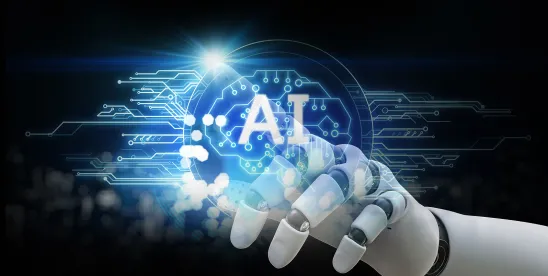The murky world of artificial intelligence-enabled inventions requires illumination. Did the USPTO’s recent guidance provide this much-needed illumination, or merely leave a trail of breadcrumbs? Some say the guidance is simply a rehashing of previous guidance post-Alice, while others find clear examples that will impact the scope and patent eligibility of existing and future claims. Takeaways from the guidance include:
- AI is viewed by the USPTO as a subset of computer-implemented inventions in this post-Alice/Mayo world, not as a uniquely different category.
- When a claim incorporates AI in the form of an abstract idea or other judicial exception but the claim as a whole integrates this into a practical application, this is patentable.
- Three AI hypotheticals are provided that practitioners should bookmark to use in developing analogies during prosecution, until the courts provide more examples.
- Creating an invention through the application of AI does not modify the subject matter analysis.
It’s Not Just Math
The two-step Alice/Mayo test (MPEP § 2106 (2022)) remains the test for patent eligibility and does not include any changes for application to AI inventions. While some examiners see AI as nothing more than math and thus abstract, the recent guidance reiterates that being based on mathematical concepts or incorporating the same does not alone render an invention ineligible. The claim as a whole may integrate an abstract idea into a practical application, which is patentable.
As with other inventions, claims to AI inventions may easily involve abstract ideas or other judicial exceptions when the claim as a whole lacks detail of the claimed invention and the claim includes several steps that fall within different groupings of abstract ideas, such as mathematical concepts, certain methods of organizing human activity, mental processes, or a fundamental economic concept or managing interactions between people. Some AI inventions, such as those directed to AI-specific hardware and systems, do not recite an abstract idea and are patent eligible under step 2A, Prong One, of the Alice/Mayo test. Many AI inventions are likely patent eligible as improvements to the functioning of a computer or to another technology or technical field, by implementing a judicial exception into a practical application under step 2A, Prong Two, of the Alice/Mayo test. However, an improvement to a judicial exception itself is not an improvement in a technology or technical field and does not result in eligibility. The guidance reiterates a key distinction for AI inventions from the Alice/Mayo test: whether the claimed invention improves the functioning of a computer or another technology or technical field, instead of simply “applying” the invention on a computer or generally linking the use of a judicial exception to a particular field of use or technological environment.
A claimed AI invention may be eligible as a technological improvement when the claim provides a particular way to achieve a desired outcome or, for example, includes a specific application of AI to a particular technological field, such as a particular solution to a problem. By contrast, simply claiming the idea of a solution or outcome will likely result in an ineligible claim that is a sufficient technological improvement.
Who is the Inventor?
Interesting questions arise when an invention is created by using AI. AI-assisted inventions — those inventions created by natural persons using one or more AI systems — may apply to product and process innovations across technologies and industries. The use of AI in invention does not change the subject matter eligibility analysis under 35 U.S.C. § 101. Whether an invention was created with the assistance of AI is not a consideration in the application of the Alice/Mayo test. The USPTO’s eligibility guidance should not prevent USPTO personnel from determining that a claim is subject matter eligible. While the recent guidance makes this clear, it does not otherwise touch on inventions created with the use of AI. Instead, that topic is reserved for Inventorship Guidance for AI-Assisted Inventions, 89 FR 10043, 10044 FN1 (February 13, 2024).
Examples for Applicants
Over the past several years, the USPTO has initiated different efforts and issued guidance on the patentability of AI (and emerging technology (ET)) inventions and AI-assisted inventions. The recent guidance provide practical suggestions for how USPTO personnel and applicants should evaluate subject matter eligibility of claims in patent applications and patents involving inventions related to AI technology. In view of these suggestions and the increasing number of applications to AI-enabled inventions, the recent guidance include some examples (Examples 47-49) that provide considerations for claims to AI inventions and that may assist applicants in drafting claims that avoid patent eligibility issues during examination. Each example includes both eligible and ineligible claims of an AI invention:
- Example 47: claims that recite an artificial neural network (ANN) to identify or detect anomalies.
- Example 48: claims that recite AI-based methods of analyzing speech signals and separating desired speech from extraneous or background speech.
- Example 49: claims that recite an AI model generated to assist in personalizing medical treatment to the individual characteristics of a particular patient.
An updated index of examples, including examples issued prior to the recent guidance, is available at www.uspto.gov/PatentEligibility[RC1] .
Updating Policies…Please Wait!
The USPTO’s recent guidance illuminates the ever-changing landscape associated with AI-enabled inventions. As the USPTO issues more patents to AI inventions, there will be more guidance from the courts regarding patent eligibility and application of the Alice/Mayo test to these claims. In this environment, the USPTO’s guidance will likely require updating and consideration of new interpretations and decisions, as well as the issuance of new examples that can provide further illumination on the blurry lines between eligibility and ineligibility for AI inventions as well as many others.
* The authors would like to thank Bracewell Patent Agent Yi Wang for his valuable contributions to this update.





 />i
/>i

